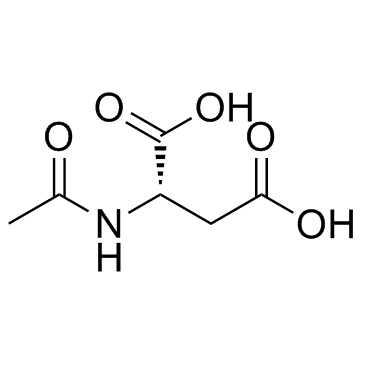N-acetyl-L-aspartic acid

N-acetyl-L-aspartic acid structure
|
Common Name | N-acetyl-L-aspartic acid | ||
|---|---|---|---|---|
| CAS Number | 997-55-7 | Molecular Weight | 175.139 | |
| Density | 1.5±0.1 g/cm3 | Boiling Point | 329.1±52.0 °C at 760 mmHg | |
| Molecular Formula | C6H9NO5 | Melting Point | 137-140 °C(lit.) | |
| MSDS | USA | Flash Point | 152.8±30.7 °C | |
|
Age-related reference values for urinary organic acids in a healthy Turkish pediatric population.
Clin. Chem. 40(6) , 862-6, (1994) Organic acid concentrations were quantified by gas chromatography and the individual acids identified by mass spectrometry in urine specimens from a healthy Turkish pediatric population of ages 2 days to 16 years, subdivided into five age groups. We quantifie... |
|
|
Metabolomic profiles delineate potential role for sarcosine in prostate cancer progression.
Nature 457(7231) , 910-4, (2009) Multiple, complex molecular events characterize cancer development and progression. Deciphering the molecular networks that distinguish organ-confined disease from metastatic disease may lead to the identification of critical biomarkers for cancer invasion an... |
|
|
Structural variation governs substrate specificity for organic anion transporter (OAT) homologs. Potential remote sensing by OAT family members.
J. Biol. Chem. 282 , 23841-53, (2007) Organic anion transporters (OATs, SLC22) interact with a remarkably diverse array of endogenous and exogenous organic anions. However, little is known about the structural features that determine their substrate selectivity. We examined the substrate binding ... |
|
|
The free radical scavenger, edaravone, ameliorates delayed neuropsychological sequelae after acute carbon monoxide poisoning in rabbits.
Undersea Hyperb. Med. 40(3) , 223-9, (2013) The mechanism underlying delayed neuropsychological sequelae (DNS) after acute carbon monoxide (CO) poisoning is unclear. There are no effective treatments for DNS. As part of a new generation of antioxidants, edaravone has been reported to improve clinical o... |
|
|
Standardized method for high-resolution 1H-NMR of cerebrospinal fluid.
Clin. Chem. 41(5) , 744-51, (1995) This study describes a standardized method for recording single-pulse 1H-nuclear magnetic resonance (1H-NMR) spectra from cerebrospinal fluid (CSF). Quantitative data for alanine, valine, threonine, and lactic acid correlated well with data obtained with conv... |
|
|
Simultaneous high performance liquid chromatographic separation of purines, pyrimidines, N-acetylated amino acids, and dicarboxylic acids for the chemical diagnosis of inborn errors of metabolism.
Clin. Biochem. 38(11) , 997-1008, (2005) To set up a novel simple, sensitive, and reliable ion-pairing HPLC method for the synchronous separation of several purines, pyrimidines, N-acetylated amino acids, and dicarboxylic acids for the chemical diagnosis and screening of inborn errors of metabolism ... |
|
|
N-acetylaspartylglutamate in Canavan disease: an adverse effector?
Eur. J. Pediatr. 158(5) , 406-9, (1999) We measured N-acetylaspartate and its precursor/product N-acetylaspartylglutamate (NAAG) in urine of patients with Canavan disease using capillary zone electrophoresis. Abnormal levels of NAAG were found in 32 of 43 patients examined. Elevated NAAG was also p... |
|
|
Abnormal excitatory amino acid metabolism in amyotrophic lateral sclerosis.
Ann. Neurol. 28(1) , 18-25, (1990) Recently, the excitatory amino acid neurotransmitter glutamate was implicated in the pathogenesis of a variety of chronic degenerative neurological diseases in humans and animals. This report describes abnormalities in excitatory amino acids in the central ne... |
|
|
Elucidation of common pharmacophores from analysis of targeted metabolites transported by the multispecific drug transporter—Organic anion transporter1 (Oat1)
Bioorg. Med. Chem. 19 , 3320-40, (2011) Organic anion transporter 1 (Oat1), first identified as NKT, is a multispecific transporter responsible for the handling of drugs and toxins in the kidney and choroid plexus, but its normal physiological role appears to be in small molecule metabolite regulat... |
|
|
High glycine levels are associated with prepulse inhibition deficits in chronic schizophrenia patients.
Schizophr. Res. 91(1-3) , 14-21, (2007) Prepulse inhibition (PPI) of the startle reflex, a measure of sensorimotor gating, is decreased in schizophrenia. The validity of a glutamatergic, N-methyl-d-aspartate receptor (NMDAR)-mediated model of PPI disruption is presently equivocal. The NMDAR antagon... |